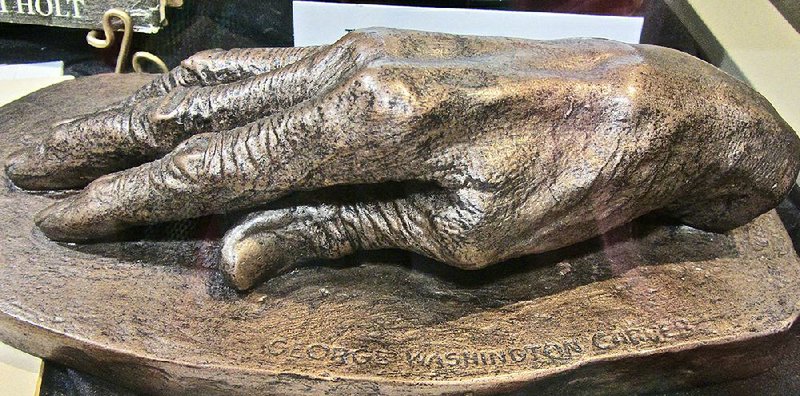At the turn of the 20th century, when Jim Crow segregation was firmly entrenched in Arkansas and the rest of the South, two prominent figures in America's black community were George Washington Carver and Booker T. Washington.
During February's yearly celebration of Black History Month, visitors can view a three-dimensional image of scientist and inventor Carver at a Pine Bluff museum. A sculpture of educator and presidential adviser Washington is displayed at another museum in the same city, long a Natural State center of black heritage.
At the University Museum and Cultural Center, 1200 N. University Drive, the prized object is a depiction of Carver's hands. Created by Isaac S. Hathaway, it is one of only two such life sculptures known to exist. The artwork is a treasure among the trove of exhibits in the University of Arkansas at Pine Bluff's museum.
The Pine Bluff/Jefferson County Historical Museum, 201 E. Fourth Ave., counts among its wide-ranging collection another Hathaway sculpture, this one a casting of Washington's head. And the four-story Masonic Temple, a National Register of Historic Places building at Fourth Avenue and State Street, was Pine Bluff's tallest structure when dedicated in 1904 by the African-American Masonic Lodge.
Other black-history sites can be found across Arkansas, a good many in the Delta where the cotton culture prevailed for so long -- with black slaves and then black sharecroppers supplying much of the agricultural labor.
From the near-century of legally enforced segregation, it's possible for travelers to draw a personal lesson: Sometimes it is better to laugh than to cry. That adage can be applied to a recollection from John H. Johnson, who became the first black man on Forbes magazine's list of the 400 wealthiest Americans.
Creator of a publishing empire that included Ebony and Jet magazines, the multi-millionaire is honored at the John H. Johnson Cultural and Educational Museum in Arkansas City, where he grew up poor. His autobiography recounts a chuckle-worthy anecdote relating to the Mississippi River town's movie theater back in the silent-film era:
"The funniest -- and saddest -- incidents of this period grew out of attempts to control the laughing of black people. When the first picture show came to town, the first floor was reserved for whites, and blacks were assigned to the balcony. Blacks were also told, in so many words, that we could only laugh when white people laughed.
"If, as often happened, a scene set off an uproar in the black section, someone below would say, 'You n*s, cut out that laughing.' The laughing would die down, with a few impudent snickers, until a scene struck the fancy of the white audience and there was a general license for blacks to laugh along with the whites.
"But it never really worked. For blacks, as a form of defiance or film criticism, always laughed too long and too loud, bringing forth the same command, 'You n*s, cut out that laughing!'"
The bungalow from Johnson's boyhood is among Arkansas locations meriting a Black History Month road trip. Others of note include Delta Cultural Center in Helena-West Helena, which offers recorded samples of the region's soulful music along with human stories from the past.
Floyd Brown-Fargo Agriculture Museum in Fargo preserves a pioneering residential high school for black students. The impressive Scott Joplin Mural in Texarkana honors the native son who became "Father of Ragtime."
An amazing alliance from the Jim Crow era is explained in Tyronza at the Southern Tenant Farmers Museum, which portrays the racially integrated union formed by 11 white and seven black Arkansans in 1934.
In Fort Smith, a statue honors Deputy U.S. Marshal Bass Reeves, a former slave and likely the first black man to hold such a lawman's role west of the Mississippi River.
Central Arkansans averse to winter road trips can refresh memories about the state's most indelible civil-rights story close to home at Little Rock Central High School National Historic Site, 2120 W. Daisy Gatson Bates Drive.
Across from the landmark school complex, the museum tells the story of a defining episode in the civil-rights movement. It portrays the nine black students who enrolled at Central High in 1957 only under the protection of federal troops, along with the following "lost year" when Little Rock voters opted to close high schools rather than desegregate.
Little Rock is also the site of Masonic Templars Cultural Center, 501 W. Ninth St. This museum is the most thorough venue relating the history of black Arkansans from slavery to Reconstruction, the Jim Crow decades, the civil-rights movement and today's complicated race relations.
Information on black history sites in the state can be found at arkansas.com.
Style on 02/12/2019
